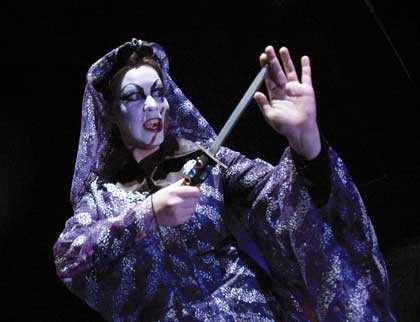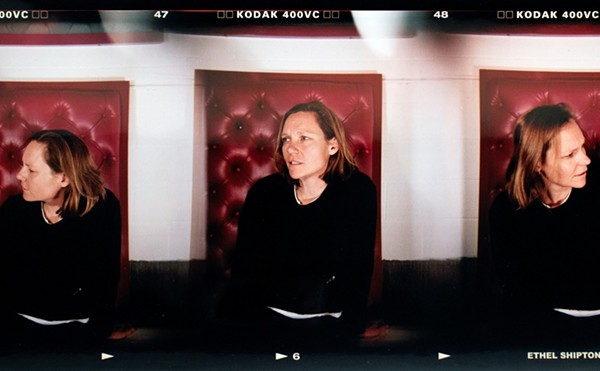The Lyric Opera’s Magic Flute was too dark, but the music transcended all
The Magic Flute (all those in favor of psychoanalysis, say “Aye”), Mozart’s final opera, was performed last weekend by the Lyric Opera of San Antonio at the Municipal Auditorium in celebration of old Wolfgang’s 250th birthday.
Existing somewhere between fairy tale and Masonic ritual, The Magic Flute tells the tale of a lost Prince, Tamino, and his journey to rescue Pamina, daughter of the Queen of the Night. Pamina has been nabbed from her mother by Sarastro, who believes the Queen has an evil influence. (All those in favor of feminist critique, say “Aye.”) In the midst of the rescue, Tamino and his sidekick, Papageno, are offered membership in a mysterious order. Tamino’s entrance into the order (did I mention it’s headed by Sarastro?) and his future with Pamina are tied to passing a series of tests.
| Cheryl Evans portrays the Queen of the Night in the San Antonio Lyric Opera's production of Mozart's Magic Flute. (Photos by Mark Greenberg) |
The Lyric’s production began darkly and ritualistically, but was soon brightened by lights — at times it looked like someone got a little crazy with the gels — and costumes. A satisfactory introduction ensued, bathed, for the most part, in uncomplimentary colors. However, the second act hit the spot: picking up the Masonic allusions again and keeping the lighting in shades of cerulean in the background and teal in the foreground.
Tamino was played with intensity and a natural, noble air by Patrick Miller. Think of a singing Orlando Bloom (in one of his better movies), with a voice that could bring tears and sniffles to the coldest-blooded of gangsters.
Dressed like a Disney princess, Jane Jennings embodied Tamino’s virginal lover-to-be, Pamina, with a sweet voice that flowed like milk and honey.
Why, like Woody Allen, do so many of us fall for the Wicked Queen? It’s because she has the best clothes — and, in this case, a bitchin’ vocal range. The Queen of the Night, a mother with a serious grudge, was ecstatically performed by Cheryl Evans, whose gorgeous and seemingly effortless upper register gilded the evening.
On the other end of the scale, Stefan Szkafarowsky, a most-impressive bass, moved with depth and seriousness as Sarastro.
| Stefan Szkafarowsky as Sarastro is joined by members of the chorus. |
The three spirits also deserve high praise. Costumed somewhere between Greek goddesses and Indian princesses, Rebecca Johnson, Lindsay Blackmon, and Liza Zuniga brought lively characterization to the spirits, as well as exquisite unity of voice.
Also to be commended for characterization and voice are Carla Mueller, Ryu-Kyung Kim, and Millinee McCurdy as the attendants to the Queen of the Night.
The birdcatcher and sidekick, Papageno, as played by Christopher Holmes, was a much-welcomed comic relief. Though he was not necessarily my favorite voice in The Magic Flute, he certainly was a favorite character.
The outright champion in the character category, however, was Amanda Borst as Papagena. She energized her fellow performers and brought movement and life to every scene she was in, with strength of voice both spoken and sung.
The set was simple: a few platforms with a staircase down the center. Despite that simplicity, the levels were used admirably. Curtains hung at the back of the stage, scumbled in purples and teals essentially they looked like some sheets I had back in the early ’90s.
The opera’s “scenery” consisted of images displayed on a screen on the back wall of the stage. This absolutely did not work, and was confusing. The images on the screen ranged from what appeared to be photographs, to paintings, to computer-generated images of aurora borealis. A little continuity, I beg of you. On top of that, the light from the screen often reduced the characters to silhouettes at times, hiding the costuming and the expressions of the performers.
William McCrary’s stage direction had its triumphs, specifically in creating three-dimensional characters, but left something to be desired in other areas. In particular, there were several overly static sequences in this production that were tedious and confusing. These motionless moments also ran contrary to the spectacle that is good opera.
Taking the good with the not-so-good, the San Antonio Lyric Opera’s production of The Magic Flute was an altogether charming musical experience, ripe for critical deconstruction. Some aural pleasures are worth paying for. •

















